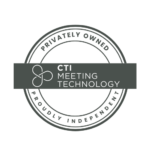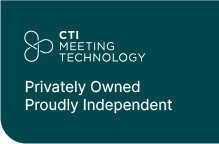As an organizer, there are many reasons why you would want to host a meeting—whether to showcase thought leadership, share valuable knowledge on a specific topic, or promote your organization and its offerings. But one thing is clear: organizing a successful event demands significant investments of time, energy, and financial resources. That’s why generating a positive ROI (return on investment) is crucial to ensure all those efforts are worth it.
While monetary gain is obviously a priority, ROI can mean much more. It can mean strengthened connections with relevant partners, increased brand visibility, or long-term promotional benefits. In short, ROI is not just about revenue from ticket sales; it’s about building relationships and achieving a long-lasting impact. Keep reading to discover some ways in which organizers can boost meeting ROI.
1. Define Clear Objectives & Agenda
The basis of an enjoyable and successful meeting lies in clearly defined objectives. These need to be SMART — specific, measurable, achievable, relevant, and time-bound. When defining these objectives, remember that they should align with the immediate outcomes you seek for the meeting and your broader business objectives.
Precision is key. The more specific your goals are, the easier it will be to measure success and evaluate outcomes. Once the objectives are set, communicate them to all stakeholders — sponsors, partners, and your internal team. This ensures everyone understands the purpose of the event and their role in driving the meeting’s success, and will act as the basis to calculate meeting ROI.
A well-prepared meeting begins long before the event itself takes place. Assigning action items and deadlines ensures follow-through on decisions made during the meeting. Documenting decisions and next steps provides a roadmap for accountability and progress tracking.
Creating a compelling agenda is crucial—not only does it drive engagement, but it also directly impacts ticket sales. Distribute the agenda through multiple channels to build excitement and encourage your partners to share with their audience. This allows attendees to come prepared and fully engaged. This is where most of your revenue will come from; the more tickets you sell, the better. Create a defined strategy and partner with other stakeholders to reach as many potential attendees as possible.
When crafting the meeting agenda, take special care of the structure, as it can significantly impact its effectiveness and overall ROI. Balancing presentation time with discussion time is vital. Aim to place content-heavy sessions in the morning when attendees are more alert while reserving more relaxed or interactive sessions for the post-lunch slump or end of the day. A well-balanced schedule maximizes both engagement and productivity.
For longer meetings, incorporate regular breaks so participants can recharge. Breaks help attendees stay focused and provide valuable networking opportunities, which can lead to future collaborations and partnerships.
2. Select the Right Partners
Choosing the right partners can make or break your meeting. From the software you use to the catering providing food at the venue, all stakeholders should be carefully selected to align with your event’s objectives. Partnering with the right people can amplify your promotional efforts, create valuable content, and broaden your meeting’s reach. In fact, an average large event is mentioned 1,389,359 times on social media before it’s finished. That’s over one million possibilities of someone attending and recommending your meeting!
When selecting your speakers, aim to balance diversity and relevance. Bringing in a diverse group of presenters creates a richer experience for all involved while ensuring relevance helps bring in more attendees.
3. Leverage Technology to Enhance Engagement
Choosing a robust software solution can automate many tasks that once took countless hours to complete, freeing your team to focus on higher-level strategies. Though the initial cost might be high, think of this technology as an investment that delivers long-term savings in both time and resources.
Rather than relying on multiple providers – which can increase complexity and costs – opt for an all-in-one event management platform that can handle every aspect of your meeting. This streamlines the planning process and reduces the risk of inefficiencies and errors.
Engagement is the secret to a successful event. The more interactive and participatory your event, the more likely your attendees will leave with a positive experience — and a positive impression of your brand. Just like a great coffee shop that keeps customers coming back, your goal should be to make your meetings so enjoyable and valuable that participants want to return again and again.
While these efforts will not provide an immediate financial return, they build long-term loyalty. At the end of the day, the more people enjoy your meeting, the more likely they are to come back and recommend it to others!
Discover how CTI’s solutions can support you with every part of your meeting.
4. Manage Time Effectively
Starting and ending on time shows respect for your attendees’ time and reinforces the value of your meeting. A well-managed schedule demonstrates professionalism and helps maintain high levels of engagement throughout the event. To stay on track, tools like a timer can subtly signal speakers when the end of their presentation time is approaching, allowing for a seamless session.
Additionally, off-topic discussions are inevitable in meetings, especially when participants are passionate about the subject. Instead of letting these tangents derail your agenda, create a “parking lot” where you can note these topics for later discussion. This way, participants feel heard, but the meeting can continue without unnecessary interruptions.
At the end of the day, efficient time management contributes directly to your meeting’s ROI by keeping everyone focused, engaged, and aligned with the meeting’s objectives, reducing wasted time and ensuring a smoother, more impactful experience. Your attendees are busy people, and going out of your way to show that you respect their time improves their overall meeting experience.
5. Monitoring & Improving
Together with the meeting objectives, key performance indicators (KPIs) are crucial to define ROI. Besides ticket revenue, these might include participant engagement levels, attendee satisfaction, and session attendance. Using event software, you can easily collect these statistics and download detailed reports that help you determine what the meeting ROI was. Monitoring the completion of action items and assessing their long-term impact is essential for understanding whether your meetings achieve the intended results.
Meetings shouldn’t be static processes. To keep driving better results, regularly review and refine your meeting practices. Analyze feedback from participants, identify trends, and pinpoint areas for improvement. Thankfully, there’s no need to go through the analytics manually; good event software will provide the statistics and reports you need to adjust your meeting strategy.
Beyond learning from your own experience, the events industry is ever-changing, so make sure you and your team stay updated on the latest meeting management practices, leveraging them to enhance the effectiveness and efficiency of your meetings.
Establishing a culture where meetings are viewed as productive and valuable will ensure their success. Lead by example, demonstrating how to run efficient, results-driven meetings. Recognize and reward effective meeting practices within your organization, whether it’s a well-facilitated discussion or creative problem-solving. You can also offer training on meeting management skills, equipping team members with the tools they need to contribute more effectively; this will positively impact your future meetings’ ROI.
Wrapping Up…
Maximizing the ROI of your meetings isn’t just about the events themselves; it’s about what happens before, during, and after the meeting. It takes a lot of trial and error, but with the right tools, you can turn every meeting into a strategic asset.
Our all-in-one event software is designed to help meeting planners like you achieve this level of success. Want to see how easy it is to improve meeting efficiency and drive results? Schedule a free demo and discover our 360º solution.





